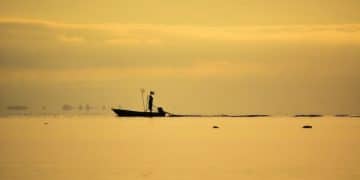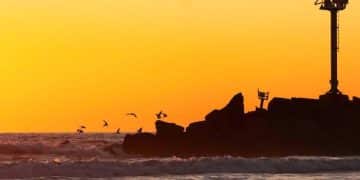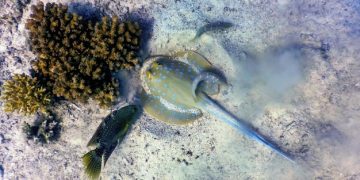Ocean Current Shifts: US Marine Ecosystems at Risk
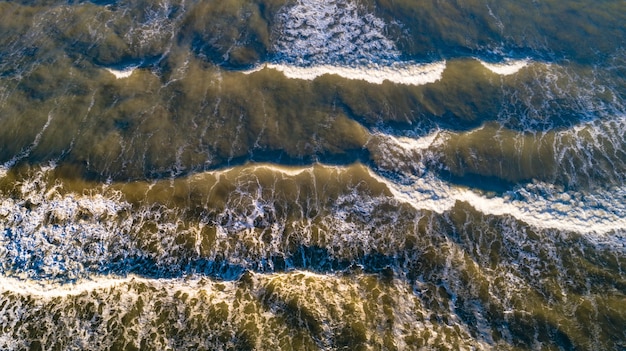
Changes in ocean currents off the US coastline pose significant threats to marine ecosystems, altering water temperatures, nutrient distribution, and habitat stability, which profoundly impacts biodiversity and local fisheries.
The vast, dynamic network of ocean currents plays a pivotal role in regulating global climate patterns and sustaining marine life. Yet, as our planet warms, these intricate systems are undergoing profound alterations. Understanding How Will Changes in Ocean Currents Affect Marine Ecosystems off the US Coastline? is now more critical than ever, as these shifts could redefine the very fabric of our coastal waters and the livelihoods they support.
The Fundamentals of Ocean Currents and Their Role
Ocean currents are essentially massive, continuous movements of water driven by a combination of forces including wind, the Coriolis effect, temperature and salinity differences, and tides. They act as Earth’s circulatory system, distributing heat from the equator towards the poles and cold water back towards the equator. This global conveyor belt has profound implications for climate, weather patterns, and marine ecosystems worldwide.
Off the US coastline, several major currents are at play. The Gulf Stream, for instance, is a powerful, warm ocean current that originates in the Gulf of Mexico and flows up the eastern seaboard of the United States and Canada before crossing the Atlantic. Its influence extends from warming coastal climates to shaping the distribution of marine species. On the Pacific coast, the California Current brings cool, nutrient-rich water southward, dramatically impacting the marine life from Alaska down to Baja California.
How Currents Impact Marine Life
- Temperature Regulation: Currents transport warm and cold water, creating specific thermal habitats crucial for many species. Changes disrupt these thermal envelopes.
- Nutrient Distribution: Upwelling, driven by specific current patterns, brings nutrient-rich deep water to the surface, fueling phytoplankton blooms, the base of the marine food web.
- Larval Dispersal: Many marine organisms, from corals to fish, rely on currents to disperse their larvae, facilitating genetic exchange and population replenishment.
- Oxygen Levels: Deep ocean circulation, influenced by currents, helps distribute oxygen throughout the water column, preventing vast deoxygenated zones.
When these currents deviate from their historical patterns, the ripple effects can be catastrophic for marine ecosystems. Altered temperatures can stress species adapted to specific thermal ranges, while changes in upwelling can lead to nutrient deserts, starving vast swathes of the food web. The delicate balance maintained by these oceanic highways is increasingly under pressure.
Drivers of Change in Ocean Currents
The Earth’s climate system is complex, and changes in ocean currents are not attributable to a single factor. Instead, they are the synergistic result of several interconnected processes, primarily driven by anthropogenic climate change.
The most significant driver is global warming. As atmospheric temperatures rise, the oceans absorb a vast amount of this excess heat. This warming causes thermal expansion of water, contributing to sea-level rise, but more importantly, it directly influences the density and stratification of ocean layers. Warmer surface waters become less dense, reducing the likelihood of vertical mixing and thus impacting deep-water formation, which is crucial for the global overturning circulation.
Melting Ice and Freshwater Influx
Another critical factor is the influx of freshwater from melting glaciers and ice sheets, particularly from Greenland and Antarctica. This freshwater, being less dense than saltwater, can sit on top of the ocean’s surface, inhibiting the sinking of cold, salty water that drives crucial components of the deep ocean currents, such as the Atlantic Meridional Overturning Circulation (AMOC).
- Greenland Ice Sheet Melt: Significant contributor to freshwater input in the North Atlantic.
- Decreased Salinity: Reduces water density, weakening the ‘engine’ of deep ocean currents.
- Potential AMOC Slowdown: Scientific models and observations suggest a weakening of the AMOC, which has global climate implications.
Changes in wind patterns, influenced by atmospheric pressure systems and Arctic amplification, also play a role. Winds drive surface currents, and alterations in their strength and direction can modify the pathways and intensity of these currents. For example, shifts in the North Atlantic Oscillation can affect the strength of the Gulf Stream’s eddies and meanders.
These drivers do not act in isolation. They interact in complex ways, creating feedback loops that can accelerate or modify the rate and scale of current changes. The scientific community is intensely studying these interactions to better predict future scenarios and their impacts on marine ecosystems.
Impacts on Marine Biodiversity Along the US Coastline
The US coastline is incredibly diverse, supporting a vast array of marine ecosystems from the vibrant coral reefs of Florida to the kelp forests of California and the rich estuaries of the Pacific Northwest. Changes in ocean currents directly threaten this biodiversity, leading to shifts in species distribution, altered breeding patterns, and even localized extinctions.
One of the most immediate impacts is on species distribution. Many marine organisms are highly sensitive to water temperature. As currents shift, they bring warmer or colder waters into regions where species are not adapted. This forces species to migrate towards more suitable thermal windows, a phenomenon known as “ocean warming-induced range shifts.” For example, some commercially important fish species off the Northeast US coast, like Atlantic cod, are moving northward as waters warm, creating challenges for fisheries management.
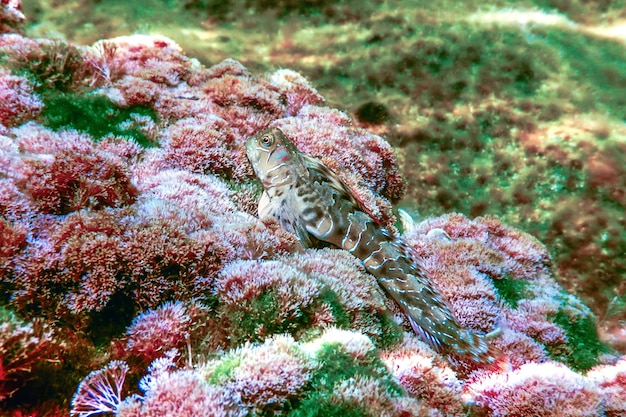
Effects on Critical Habitats
Coastal habitats are particularly vulnerable. Coral reefs, sensitive to thermal stress and ocean acidification (which is exacerbated by altered oceanic circulation patterns that affect CO2 absorption), face increased bleaching events. Seagrass beds and kelp forests, vital nurseries and food sources, are also susceptible to changes in water flow and nutrient delivery, which can reduce their productivity and resilience.
- Coral Bleaching: Increased frequency and severity due to warmer, stagnant waters.
- Kelp Forest Retreat: Sensitive to warm water intrusions and nutrient depletion.
- Seagrass Decline: Vulnerable to altered salinity and light penetration from current-driven changes.
The timing and magnitude of upwelling events also play a crucial role. If nutrient-rich upwelling decreases or shifts geographically, it can lead to reduced primary productivity, impacting the entire food web from plankton to top predators like whales and seabirds. This has been observed in parts of the California Current System, where changes in wind-driven upwelling patterns have been linked to declines in forage fish populations.
Furthermore, altered currents can disrupt the dispersal of marine larvae, which is essential for population connectivity and genetic diversity. If currents no longer carry larvae to traditional spawning grounds or suitable settlement areas, it can sever these crucial ecological links, leading to isolated and vulnerable populations.
Threats to Fisheries and Coastal Economies
The health of marine ecosystems is intrinsically linked to the economic vitality of US coastal communities. Changes in ocean currents, by impacting biodiversity and habitat, directly threaten the sustainability of fisheries and other ocean-dependent industries, leading to significant economic repercussions.
Commercial and recreational fisheries are at the forefront of these impacts. As fish stocks shift their ranges due to changing temperatures and nutrient availability, fishing fleets must adapt. This can mean longer travel distances, higher fuel costs, and new regulatory challenges as species move across state or international boundaries. Fishermen who have traditionally targeted specific species in familiar waters may find their catches dwindling or disappearing entirely.
Economic Cascading Effects
The economic impact extends beyond direct fishing profits. Seafood processing plants, aquaculture operations, and related industries like gear suppliers and boat repair services also suffer. Local seafood restaurants and tourism sectors that rely on the appeal of fresh, local catches could see a decline in business. Entire coastal economies, particularly those heavily reliant on fishing, face significant disruption.
- Increased Operational Costs: Longer trips, new gear, and adapting to new species.
- Market Disruptions: Changes in supply affect prices and availability.
- Job Losses: Fishing and related industries face declining employment opportunities.
Beyond fisheries, other coastal economies are also vulnerable. Changes in currents can affect coastal erosion patterns, potentially increasing the vulnerability of coastal infrastructure and homes to storms and sea-level rise. Marinas, harbors, and ports might need to adapt to altered wave patterns and sediment transport. Ecosystem services, such as nutrient cycling and waste assimilation, which are indirectly supported by healthy currents, could also be compromised, leading to further costs for coastal communities.
The unpredictability associated with these changes adds another layer of challenge. Businesses and communities struggle to plan and invest when the future of their primary natural resources is uncertain. This necessitates robust adaptation strategies and proactive management to mitigate the economic fallout.
Case Studies: Regional Impacts Along the US Coast
To truly grasp the implications of changing ocean currents, it’s essential to examine specific regions along the US coastline. Each area, with its unique oceanographic features and ecosystems, faces distinct challenges as currents evolve.
Northeast US Coast: This region is experiencing some of the most rapid ocean warming globally, partly due to shifts in the Gulf Stream and a weakening of the Atlantic Meridional Overturning Circulation (AMOC). The Gulf Stream has shown variability, at times shifting its northern boundary closer to the coast, bringing warmer waters into critical fishing grounds like the Gulf of Maine. This has led to dramatic shifts in fish populations, with species like lobster moving to deeper, cooler waters, and warming-tolerant species moving in. The historically cold-adapted Atlantic cod population has suffered significant declines, largely attributed to thermal stress and habitat compression.
Southeast US and Gulf of Mexico: This area is heavily influenced by the Gulf Stream and Loop Current. Changes in the Loop Current, an anticyclonic eddy that extends into the Gulf of Mexico, can affect hurricane intensification by providing a deep layer of warm water. Altered current patterns here also impact the dispersal of oil spills, as demonstrated by the Deepwater Horizon disaster. Furthermore, the sensitive coral reef ecosystems off Florida are experiencing increased thermal stress and bleaching events, intensified by prolonged exposure to warmer waters delivered by modified currents.
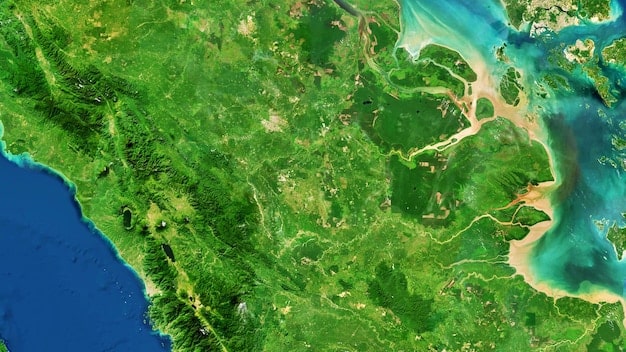
Pacific Northwest and California Coast: The California Current System (CCS) is characterized by seasonal upwelling, which fuels its rich productivity. However, changes in wind patterns and broader oceanographic conditions have led to periods of weakened or displaced upwelling. This has resulted in marine heatwaves, such as “The Blob” phenomenon from 2013-2016, which brought anomalously warm water across the North Pacific. These heatwaves severely impacted marine life, leading to mass mortality events for seabirds, changes in salmon migration, and delays in Dungeness crab fisheries due to toxin accumulation in shellfish, directly linked to harmful algal blooms thriving in warmer waters.
These regional examples underscore the localized, yet interconnected, nature of current changes and their far-reaching consequences for marine ecosystems and human communities. The variability and dynamic nature of these impacts mean that adaptation strategies must be flexible and locally tailored.
Mitigation and Adaptation Strategies
Addressing the profound impacts of changing ocean currents on US marine ecosystems requires a dual approach: mitigating the underlying causes (primarily climate change) and developing robust adaptation strategies to cope with the inevitable changes.
Mitigation: The most fundamental mitigation strategy is to drastically reduce global greenhouse gas emissions. This involves transitioning away from fossil fuels to renewable energy sources, improving energy efficiency, and implementing carbon capture technologies. While the impacts of past emissions are already locked in, rapid and sustained mitigation efforts can limit the severity and extent of future changes in ocean currents and their associated consequences.
Adaptation Strategies for Coastal Communities and Marine Management
- Dynamic Fisheries Management: Moving away from fixed management boundaries towards more flexible systems that can adapt to changing fish distributions. This includes real-time data sharing and adaptive quotas.
- Marine Protected Areas (MPAs) and Networks: Designing MPAs that are climate-resilient and interconnected, allowing species to shift their ranges and providing refuge from stress.
- Ecosystem-Based Management: Managing marine resources holistically, considering the entire ecosystem rather than individual species, to build resilience.
- Habitat Restoration: Protecting and restoring critical coastal habitats like coral reefs, seagrass beds, and kelp forests to enhance their resilience to environmental changes.
- Early Warning Systems: Developing and improving systems to predict marine heatwaves, harmful algal blooms, and other climate-related events, allowing for proactive responses.
- International Collaboration: Since currents do not respect national borders, international cooperation in research, data sharing, and management is crucial.
Research and Monitoring: Continued investment in oceanographic research and long-term monitoring programs is essential. Understanding the intricacies of ocean currents, predicting their future behavior, and assessing their impacts requires sophisticated modeling, satellite observations, and in-situ measurements. This scientific understanding forms the bedrock for effective policy and management decisions.
Furthermore, fostering collaboration between scientists, policymakers, and local stakeholders (including fishing communities) is vital for developing practical and acceptable solutions. Empowering local communities with knowledge and resources can enhance their adaptive capacity and build resilience in the face of these complex environmental shifts. The challenge is immense, but through concerted action and informed decision-making, we can strive to protect our invaluable marine ecosystems.
| Key Aspect | Brief Description |
|---|---|
| 🌊 Current Shifts | Global warming alters ocean current patterns, affecting water temperature and flow. |
| 🐠 Biodiversity Impact | Marine species migrate, habitats degrade, and food webs are disrupted due to changes. |
| 💲 Economic Threat | Fisheries and coastal economies face significant financial losses and job impacts. |
| 💡 Mitigation/Adaptation | Reducing emissions and implementing flexible management are crucial for resilience. |
Frequently Asked Questions About Ocean Current Impacts
The main drivers include global warming, which increases water temperature and alters density, and the melting of ice sheets and glaciers, which introduces vast amounts of freshwater. These factors weaken the ‘thermohaline circulation’ and modify wind patterns, collectively influencing current strength and direction.
Many marine species are highly sensitive to water temperature. As currents shift, they bring warmer or colder waters, forcing species to migrate to more suitable thermal areas. This can lead to new species appearing in previously unpopulated zones, while others disappear from traditional habitats, impacting local ecosystems.
The economic consequences are significant, primarily impacting fisheries as fish stocks shift their locations. This results in increased operational costs for fishing fleets, market disruptions for seafood businesses, and potential job losses in fishing and related industries, threatening the economic stability of coastal towns.
Absolutely. Ocean currents play a critical role in global heat distribution. Alterations in these currents can influence regional temperatures, precipitation patterns, and the intensity and frequency of extreme weather events, including coastal storms and marine heatwaves, indirectly affecting coastal demographics.
Mitigation primarily involves reducing global greenhouse gas emissions to slow ocean warming. Adaptation strategies include implementing dynamic fisheries management, establishing climate-resilient marine protected areas, investing in habitat restoration, and improving early warning systems for marine heatwaves, all requiring ongoing research and international collaboration.
Conclusion
The trajectory of changing ocean currents off the US coastline presents a profound challenge to marine ecosystems and the human communities that depend on them. From altering the very fabric of marine biodiversity to threatening the livelihoods sustained by coastal fisheries, the impacts are complex and far-reaching. While the scale of the issue can feel overwhelming, understanding these changes is the first step towards resilience. Through a combination of aggressive mitigation of climate change, sophisticated scientific research, and collaborative, adaptive management strategies, we can strive to safeguard our invaluable marine resources for future generations. The health of our oceans reflects the health of our planet, and protecting these vital currents is paramount to a sustainable future.

